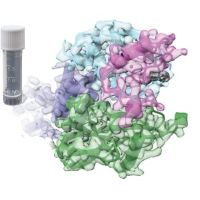Specification
| Description | Recombinant protein from the full-length sequence of homo sapiens cullin 3 (CUL3), transcript variant 1 (NM_003590). |
| Organism | Homo sapiens (Human) |
| Expression Host | Human Cells |
| Tag Info | His or DYKDDDDK. Please contact us if you need further information or require specific designed tag. |
| Purity | Greater than 90% by SDS-PAGE gel |
| Uniprot ID | Q13618 |
| Entry Name | CUL3_HUMAN |
| Gene Names | CUL3 KIAA0617 |
| Alternative Gene Names | KIAA0617 |
| Alternative Protein Names | Cullin-3 (CUL-3) |
| Application | Antigens, Western, ELISA and other in vitro binding or in vivo functional assays, and protein-protein interaction studies; For research & development use only! |
| Buffer | Purified protein formulated in a sterile solution of PBS buffer, pH7.2, without any preservatives |
| Endotoxin | Endotoxin level is < 0.1 ng/µg of protein (<1EU /µg) |
| Length | 768 |
| Molecular Weight(Da) | 88930 |
| Protein Sequence | (The sequence of expressed protein may have some variation from the sequence shown below. Please contact us for the exact sequence.) MSNLSKGTGSRKDTKMRIRAFPMTMDEKYVNSIWDLLKNAIQEIQRKNNSGLSFEELYRNAYTMVLHKHGEKLYTGLREVVTEHLINKVREDVLNSLNNNFLQTLNQAWNDHQTAMVMIRDILMYMDRVYVQQNNVENVYNLGLIIFRDQVVRYGCIRDHLRQTLLDMIARERKGEVVDRGAIRNACQMLMILGLEGRSVYEEDFEAPFLEMSAEFFQMESQKFLAENSASVYIKKVEARINEEIERVMHCLDKSTEEPIVKVVERELISKHMKTIVEMENSGLVHMLKNGKTEDLGCMYKLFSRVPNGLKTMCECMSSYLREQGKALVSEEGEGKNPVDYIQGLLDLKSRFDRFLLESFNNDRLFKQTIAGDFEYFLNLNSRSPEYLSLFIDDKLKKGVKGLTEQEVETILDKAMVLFRFMQEKDVFERYYKQHLARRLLTNKSVSDDSEKNMISKLKTECGCQFTSKLEGMFRDMSISNTTMDEFRQHLQATGVSLGGVDLTVRVLTTGYWPTQSATPKCNIPPAPRHAFEIFRRFYLAKHSGRQLTLQHHMGSADLNATFYGPVKKEDGSEVGVGGAQVTGSNTRKHILQVSTFQMTILMLFNNREKYTFEEIQQETDIPERELVRALQSLACGKPTQRVLTKEPKSKEIENGHIFTVNDQFTSKLHRVKIQTVAAKQGESDPERKETRQKVDDDRKHEIEAAIVRIMKSRKKMQHNVLVAEVTQQLKARFLPSPVVIKKRIEGLIEREYLARTPEDRKVYTYVA |
Background
| Function | FUNCTION: Core component of multiple cullin-RING-based BCR (BTB-CUL3-RBX1) E3 ubiquitin-protein ligase complexes which mediate the ubiquitination and subsequent proteasomal degradation of target proteins. BCR complexes and ARIH1 collaborate in tandem to mediate ubiquitination of target proteins (PubMed:27565346). As a scaffold protein may contribute to catalysis through positioning of the substrate and the ubiquitin-conjugating enzyme. The E3 ubiquitin-protein ligase activity of the complex is dependent on the neddylation of the cullin subunit and is inhibited by the association of the deneddylated cullin subunit with TIP120A/CAND1. The functional specificity of the BCR complex depends on the BTB domain-containing protein as the substrate recognition component. BCR(KLHL42) is involved in ubiquitination of KATNA1. BCR(SPOP) is involved in ubiquitination of BMI1/PCGF4, BRMS1, MACROH2A1 and DAXX, GLI2 and GLI3. Can also form a cullin-RING-based BCR (BTB-CUL3-RBX1) E3 ubiquitin-protein ligase complex containing homodimeric SPOPL or the heterodimer formed by SPOP and SPOPL; these complexes have lower ubiquitin ligase activity. BCR(KLHL9-KLHL13) controls the dynamic behavior of AURKB on mitotic chromosomes and thereby coordinates faithful mitotic progression and completion of cytokinesis. BCR(KLHL12) is involved in ER-Golgi transport by regulating the size of COPII coats, thereby playing a key role in collagen export, which is required for embryonic stem (ES) cells division: BCR(KLHL12) acts by mediating monoubiquitination of SEC31 (SEC31A or SEC31B) (PubMed:22358839, PubMed:27716508). BCR(KLHL3) acts as a regulator of ion transport in the distal nephron; by mediating ubiquitination of WNK4 (PubMed:23387299, PubMed:23453970, PubMed:23576762). The BCR(KLHL20) E3 ubiquitin ligase complex is involved in interferon response and anterograde Golgi to endosome transport: it mediates both ubiquitination leading to degradation and 'Lys-33'-linked ubiquitination (PubMed:20389280, PubMed:21840486, PubMed:21670212, PubMed:24768539). The BCR(KLHL21) E3 ubiquitin ligase complex regulates localization of the chromosomal passenger complex (CPC) from chromosomes to the spindle midzone in anaphase and mediates the ubiquitination of AURKB (PubMed:19995937). The BCR(KLHL22) ubiquitin ligase complex mediates monoubiquitination of PLK1, leading to PLK1 dissociation from phosphoreceptor proteins and subsequent removal from kinetochores, allowing silencing of the spindle assembly checkpoint (SAC) and chromosome segregation (PubMed:23455478). The BCR(KLHL22) ubiquitin ligase complex is also responsible for the amino acid-stimulated 'Lys-48' polyubiquitination and proteasomal degradation of DEPDC5. Through the degradation of DEPDC5, releases the GATOR1 complex-mediated inhibition of the TORC1 pathway (PubMed:29769719). The BCR(KLHL25) ubiquitin ligase complex is involved in translational homeostasis by mediating ubiquitination and subsequent degradation of hypophosphorylated EIF4EBP1 (4E-BP1) (PubMed:22578813). The BCR(KBTBD8) complex acts by mediating monoubiquitination of NOLC1 and TCOF1, leading to remodel the translational program of differentiating cells in favor of neural crest specification (PubMed:26399832). Involved in ubiquitination of cyclin E and of cyclin D1 (in vitro) thus involved in regulation of G1/S transition. Involved in the ubiquitination of KEAP1, ENC1 and KLHL41 (PubMed:15983046). In concert with ATF2 and RBX1, promotes degradation of KAT5 thereby attenuating its ability to acetylate and activate ATM. The BCR(KCTD17) E3 ubiquitin ligase complex mediates ubiquitination and degradation of TCHP, a down-regulator of cilium assembly, thereby inducing ciliogenesis (PubMed:25270598). The BCR(KLHL24) E3 ubiquitin ligase complex mediates ubiquitination of KRT14, controls KRT14 levels during keratinocytes differentiation, and is essential for skin integrity (PubMed:27798626). The BCR(KLHL18) E3 ubiquitin ligase complex mediates the ubiquitination of AURKA leading to its activation at the centrosome which is required for initiating mitotic entry (PubMed:23213400). The BCR(KEAP1) E3 ubiquitin ligase complex acts as a key sensor of oxidative and electrophilic stress by mediating ubiquitination and degradation of NFE2L2/NRF2, a transcription factor regulating expression of many cytoprotective genes (PubMed:15601839, PubMed:16006525). As part of the CUL3(KBTBD6/7) E3 ubiquitin ligase complex functions mediates 'Lys-48' ubiquitination and proteasomal degradation of TIAM1 (PubMed:25684205). By controlling the ubiquitination of that RAC1 guanine exchange factors (GEF), regulates RAC1 signal transduction and downstream biological processes including the organization of the cytoskeleton, cell migration and cell proliferation (PubMed:25684205). {ECO:0000269|PubMed:10500095, ECO:0000269|PubMed:11311237, ECO:0000269|PubMed:15601839, ECO:0000269|PubMed:15897469, ECO:0000269|PubMed:15983046, ECO:0000269|PubMed:16006525, ECO:0000269|PubMed:16524876, ECO:0000269|PubMed:17543862, ECO:0000269|PubMed:18397884, ECO:0000269|PubMed:19261606, ECO:0000269|PubMed:19995937, ECO:0000269|PubMed:20389280, ECO:0000269|PubMed:21670212, ECO:0000269|PubMed:21840486, ECO:0000269|PubMed:22085717, ECO:0000269|PubMed:22358839, ECO:0000269|PubMed:22578813, ECO:0000269|PubMed:22632832, ECO:0000269|PubMed:23213400, ECO:0000269|PubMed:23387299, ECO:0000269|PubMed:23453970, ECO:0000269|PubMed:23455478, ECO:0000269|PubMed:23576762, ECO:0000269|PubMed:24768539, ECO:0000269|PubMed:25270598, ECO:0000269|PubMed:25684205, ECO:0000269|PubMed:26399832, ECO:0000269|PubMed:27565346, ECO:0000269|PubMed:27716508, ECO:0000269|PubMed:27798626, ECO:0000269|PubMed:29769719}. |
| Pathway | Protein modification; protein ubiquitination. |
| Protein Families | Cullin family |
| Tissue Specificity | Brain, spermatozoa, and testis (at protein level). Widely expressed. {ECO:0000269|PubMed:28395323}. |
QC Data
| Note | Please contact us for QC Data |
| Product Image (Reference Only) |  |

